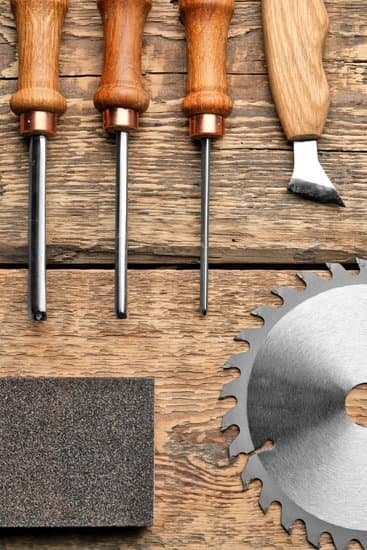Interested in woodworking? Whether you are a hobbyist or a professional, understanding how to use a shaper is essential for creating precise and intricate designs in your woodworking projects. A shaper is a versatile tool that allows woodworkers to shape and mold wood with precision, making it an indispensable device in any woodworking workshop. In this article, we will provide a comprehensive guide on how to use a shaper woodworking, from safety precautions to advanced techniques and project ideas.
Before delving into the specifics of using a shaper, it is important to understand what exactly a shaper is and its significance in the realm of woodworking. Additionally, we will discuss the different types of shapers available in the market, providing insights into their unique features and functionalities.
Furthermore, we will emphasize the crucial aspect of safety when working with a shaper. This includes wearing the appropriate safety gear and adhering to necessary precautions to prevent accidents while operating this powerful tool. We will also provide detailed instructions on setting up the shaper for specific woodworking projects, as well as tips on choosing the right shaper bits for different tasks.
As we progress through this article, we will cover basic and advanced shaper woodworking techniques, including maintenance and care tips for ensuring optimal performance of the equipment. Additionally, we will explore project ideas that showcase the versatility of a shaper in creating custom moldings and intricate designs for various woodworking endeavors.
Safety Precautions Before Using a Shaper
Before delving into the exciting world of shaper woodworking, it is crucial to prioritize safety. Woodworking with a shaper can be an enjoyable and rewarding activity, but it also presents potential hazards if safety precautions are not taken seriously. Here are some important safety measures to keep in mind before using a shaper:
- Wear the necessary safety gear: Prior to operating a shaper, ensure that you have equipped yourself with appropriate safety gear. This includes goggles to protect your eyes from flying wood chips, gloves to shield your hands from sharp edges and ear protection to minimize exposure to loud noise.
- Inspect the shaper for any damage: Before using the equipment, carefully inspect the shaper for any signs of damage or wear and tear. Ensure that all components are working properly and there are no loose parts that could cause accidents during operation.
- Secure the workpiece and use push blocks: When feeding the wood through the shaper, always use push blocks or sticks to maintain a safe distance between your hands and the cutting tool. Additionally, make sure that the workpiece is securely fastened to prevent it from getting dislodged during shaping.
By following these essential safety precautions, woodworkers can significantly reduce the risk of accidents and injuries while using a shaper. It is important to approach woodworking with caution and always prioritize personal safety above all else.
Now that we have covered the importance of safety when using a shaper woodworking, let’s proceed with understanding how to set up this powerful tool for various woodworking projects. The next section will provide a step-by-step guide on setting up the shaper along with tips for adjusting its speed, height, and depth for optimal results.
Setting Up the Shaper
Stay tuned as we explore how best to maximize this useful power tool.
Setting Up the Shaper
Once you have chosen the right shaper for your woodworking project, the next step is setting it up properly. Proper setup is crucial to ensure that you achieve the desired results and maintain safety while using a shaper. Here is a step-by-step guide on how to set up the shaper for specific woodworking projects.
First, start by selecting the appropriate shaper bit for your project. Different shaper bits are designed for specific tasks such as edge forming, grooving, and molding. Ensure that the chosen bit is compatible with your shaper and suitable for the type of cut you want to make.
Next, adjust the speed of the shaper according to the material and type of cut. Lower speeds are ideal for larger diameter cutters and harder woods, while higher speeds work well with smaller diameter cutters and softer woods. Refer to the manufacturer’s guidelines for recommended speed settings.
After adjusting the speed, set the height and depth of the shaper cutter. The height determines how much material will be removed, while the depth dictates how deep the cut will be. Make precise adjustments based on your woodworking plans and ensure that all measurements are accurate before proceeding with any cuts.
Lastly, ensure that all safety guards are in place and functioning properly before turning on the shaper. Double-check that the fence is aligned correctly for straight cuts or adjusted at an angle for beveled cuts, depending on your project requirements.
Following these steps will help you set up your shaper effectively, ensuring optimal results while minimizing risks. Always refer to your specific shaper’s manual for detailed instructions on setup procedures relevant to your model.
| Shaper Setup Step | Importance |
|---|---|
| Selecting appropriate bit | Ensures compatibility with shaper and suitable cut |
| Adjusting speed | Determines performance based on wood type and cutter size |
| Setting height and depth | Precise measurements crucial for accurate cuts |
| Checking safety guards | Minimizes risk of accidents during operation |
Choosing the Right Shaper Bits
When it comes to using a shaper in woodworking, choosing the right shaper bits is crucial for achieving the desired results. Shaper bits come in a variety of shapes and sizes, each designed for specific woodworking tasks. Understanding the different types of shaper bits and their specific uses is essential for maximizing the versatility of a shaper.
Types of Shaper Bits
There are several types of shaper bits available in the market, each serving a different purpose. Straight bits are commonly used for edge forming and grooving, while raised panel bits are used for creating decorative paneling on furniture or cabinets. There are also specialized bits such as cope and stick sets for stile and rail construction, and beading bits for adding decorative details to woodworking projects.
Choosing the Right Shaper Bit
When selecting a shaper bit for a specific woodworking task, it’s important to consider factors such as the type of cut needed, the material being used, and the desired finish. For example, if you’re working with hardwoods, a carbide-tipped bit is recommended for durability and precision. Additionally, understanding the profile and size requirements of the project will help in choosing the right shaper bit for optimal results.
Tips for Selecting Shaper Bits
To ensure that you’re choosing the right shaper bit for your woodworking project, consider investing in a variety of commonly used bits to cover different cutting needs. It’s also important to select high-quality bits from reputable manufacturers to ensure performance and longevity. Lastly, always refer to the manufacturer’s guidelines for compatibility with your specific shaper model before making a purchase.
Understanding how to choose the right shaper bit according to your project needs will elevate your woodworking capabilities with a shaper. By considering factors such as type, material suitability, and quality assurance when selecting shaper bits, woodworkers can achieve clean and precise cuts while maximizing efficiency during their projects.
Basic Shaper Woodworking Techniques
Shaper woodworking is a versatile and powerful tool that allows woodworkers to create a wide range of shapes and designs with precision. In this section, we will explore the basic techniques for using a shaper in woodworking projects.
Edge Forming
One of the most common uses of a shaper in woodworking is for edge forming. This technique involves shaping the edges of a piece of wood to create decorative profiles or smooth, rounded edges. To achieve clean and precise results, it is important to use the appropriate shaper bit and set the speed and depth of the shaper correctly. Additionally, using a featherboard can help ensure that the workpiece stays securely in place during the shaping process.
Rabbeting
Rabbeting is another basic technique that can be accomplished using a shaper. This involves cutting a step-shaped recess along the edge or end of a piece of wood, which is commonly used for joining pieces together or creating space for panels. When rabbeting with a shaper, it’s essential to use the right size and type of rabbeting bit and adjust the depth accordingly to achieve the desired result.
Grooving
Grooving with a shaper involves cutting long, straight channels into a workpiece, which is often used for installing panels or creating decorative details on furniture or cabinetry. When performing grooving with a shaper, it’s crucial to secure the workpiece properly and make incremental cuts to avoid putting excessive strain on the machine or producing rough edges.
By mastering these basic techniques, woodworkers can effectively utilize a shaper in various woodworking projects to achieve professional-looking results with precision and efficiency. It’s essential to practice these techniques carefully and familiarize yourself with the capabilities of your specific shaper model before taking on more complex tasks.
Advanced Shaper Woodworking Techniques
Once you have mastered the basic techniques of using a shaper in woodworking, you can move on to more advanced and complex tasks. These advanced techniques allow you to create intricate designs and finely crafted woodwork with precision and efficiency.
One of the most popular advanced techniques with a shaper is raised panel cutting, which adds dimension and elegance to furniture and cabinetry. By utilizing the proper shaper bits and mastering the necessary adjustments, you can achieve professional-quality raised panels for your woodworking projects.
Another advanced technique that can be accomplished with a shaper is stile and rail construction. This technique is commonly used in creating doors, cabinets, and other wooden structures where precise joinery is required. Using specialized shaper bits and carefully adjusting the settings of the shaper, you can achieve seamless stile and rail joints that add strength and visual appeal to your woodworking projects.
To successfully execute these advanced shaper woodworking techniques, it is crucial to have a comprehensive understanding of how to operate the shaper effectively and safely. Additionally, practice and patience are essential in mastering these advanced skills. With dedication and attention to detail, you can elevate your woodworking projects to a professional level using advanced shaper techniques.
| Shaper Woodworking Technique | Description |
|---|---|
| Raised Panel Cutting | Create dimension and elegance in furniture/cabinetry |
| Stile and Rail Construction | Precise joinery for doors/cabinets/wooden structures |
Maintenance and Care for Shapers
Proper maintenance and care for your shaper woodworking equipment is essential to ensure its long-lasting performance and safety. Here are some guidelines on how to maintain and care for your shaper:
- Regular Cleaning: It is important to clean the shaper after each use to remove any sawdust, dirt, or debris that may have accumulated. Use a brush or vacuum to effectively clean all the nooks and crannies of the machine.
- Lubrication: Check and lubricate the moving parts of the shaper regularly to reduce friction and wear. Be sure to use the appropriate lubricant recommended by the manufacturer.
- Inspecting Blades and Bits: Inspect the blades and bits for any signs of wear or damage. Replace them if necessary to ensure optimal cutting performance.
- Checking Belts and Pulleys: Regularly inspect the belts and pulleys for wear, tension, and alignment. Adjust or replace them as needed to maintain smooth operation.
In addition to regular maintenance, it is important to actively care for your shaper woodworking equipment in order to prevent premature wear and tear. Here are some tips on how to care for your shaper:
- Store Properly: When not in use, store the shaper in a clean, dry area away from moisture or extreme temperatures.
- Follow Manufacturer Guidelines: Always refer to the manufacturer’s guidelines for specific maintenance routines and care instructions for your particular model of shaper.
- Avoid Overworking: Use the shaper within its recommended capacity and avoid overworking it, as this can lead to decreased performance and potential damage.
By following these maintenance and care practices, you can ensure that your shaper woodworking equipment remains in top condition for years to come.
Remember that proper maintenance not only ensures longevity but also keeps you safe while using a shaper woodworking tool. Preventative care will save you time, money, and frustration in future repairs. Always follow these steps in between uses even if daily usage isn’t part of your regular routine.
These simple steps should help guide you with maintaining proper upkeep with a variety of woodshop tools.
Project Ideas for Using a Shaper
When it comes to woodworking, the shaper is a versatile and essential tool that allows for precision and customization in your projects. Once you have familiarized yourself with the basic and advanced techniques of using a shaper, the next step is to explore project ideas that can truly showcase the capabilities of this powerful tool.
One popular project idea for using a shaper is creating custom moldings. With the ability to use various shaper bits and adjust the speed and depth of the shaper, you can craft unique moldings for furniture, cabinetry, or even decorative accents in your home. Whether it’s beaded edges, cove moldings, or intricate designs, a shaper allows for endless possibilities when it comes to creating customized moldings.
Another exciting project idea for using a shaper is crafting intricate designs on wooden panels or boards. The precision and control provided by a shaper make it an ideal tool for creating detailed patterns, grooves, or decorative elements on wood surfaces. From traditional panel designs to contemporary geometric patterns, a shaper opens up a world of creativity for woodworking enthusiasts.
Furthermore, using a shaper opens up opportunities for creating unique joinery and construction details in woodworking projects. Stile and rail construction, which involves creating interlocking joints in cabinet doors or frames, can be achieved with accuracy and efficiency using a shaper. Additionally, raised panel cutting – a technique commonly used in making cabinet doors – can be easily accomplished with the help of a well-equipped shaper.
By exploring these project ideas and experimenting with different techniques on a shaper, woodworkers can truly elevate their craftsmanship to new heights. The precision and versatility offered by this tool make it an invaluable asset in any woodworking workshop.
As you embark on these project ideas using a shaper woodworking, remember to prioritize safety precautions and proper maintenance of your equipment in order to achieve optimal results while ensuring the longevity of your tools. Happy crafting.
Conclusion
In conclusion, learning how to use a shaper in woodworking can greatly enhance the precision and versatility of your projects. By following the safety precautions outlined and properly setting up the shaper, woodworkers can achieve clean and precise cuts for various tasks.
Understanding the different types of shaper bits and their uses allows for more creativity and efficiency in woodworking projects. From basic techniques like edge forming to advanced methods such as raised panel cutting, a shaper opens up a world of possibilities for creating custom moldings and intricate designs.
It is important to note that regular maintenance and care for a shaper is essential to ensure its long-lasting performance. By following guidelines on cleaning, troubleshooting common issues, and ensuring proper functioning, woodworkers can maximize the lifespan of their equipment. Additionally, exploring project ideas for using a shaper can inspire individuals to take their woodworking skills to the next level, from crafting intricate designs to creating custom moldings for furniture or home decor.
In closing, understanding how to use a shaper in woodworking not only adds precision and efficiency to projects but also opens up opportunities for more complex and creative endeavors. By harnessing the capabilities of a shaper, woodworkers can achieve professional-level results that showcase craftsmanship and attention to detail. With the right knowledge and techniques, utilizing a shaper can take woodworking projects to new heights.
Frequently Asked Questions
How Does a Woodworking Shaper Work?
A woodworking shaper works by using a cutter head to shape wood, similar to a router but on a larger scale. The machine allows for precise cutting and molding of wood, making it versatile for various woodworking projects.
What Can I Do With a Wood Shaper?
With a wood shaper, you can create custom moldings, edge profiles, and joints for furniture, cabinets, doors, and other woodworking projects. Its precision and power make it suitable for shaping hardwoods and producing complex designs with ease.
Is a Shaper Better Than a Router?
Whether a shaper is better than a router depends on the specific needs of the woodworking project. While routers are more versatile and portable, shapers are more powerful and designed for heavy-duty shaping tasks. For large-scale professional woodworking operations, a shaper may be preferred for its precision and efficiency.

Hi everyone! I’m a woodworker and blogger, and this is my woodworking blog. In my blog, I share tips and tricks for woodworkers of all skill levels, as well as project ideas that you can try yourself.





